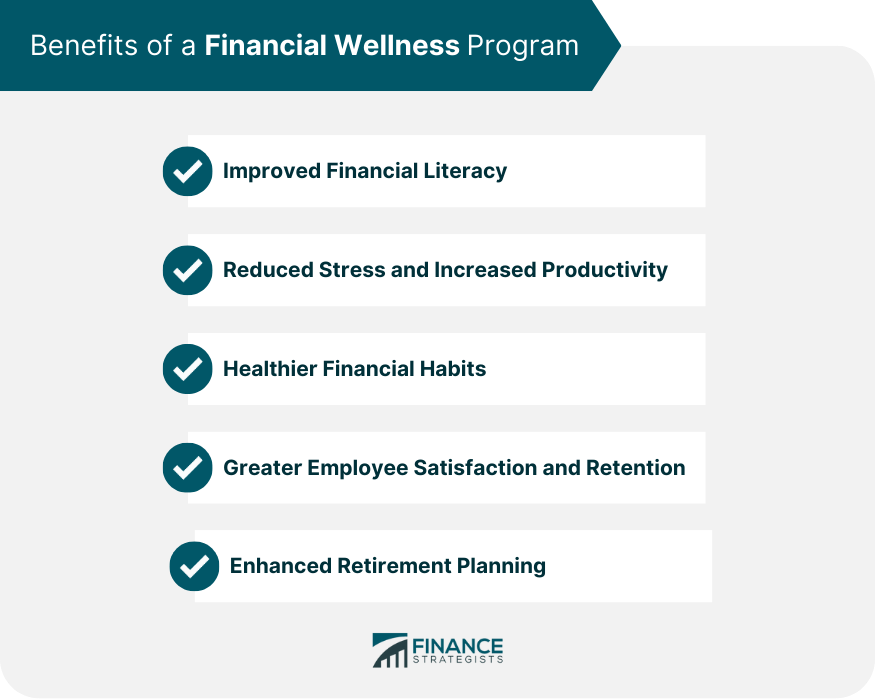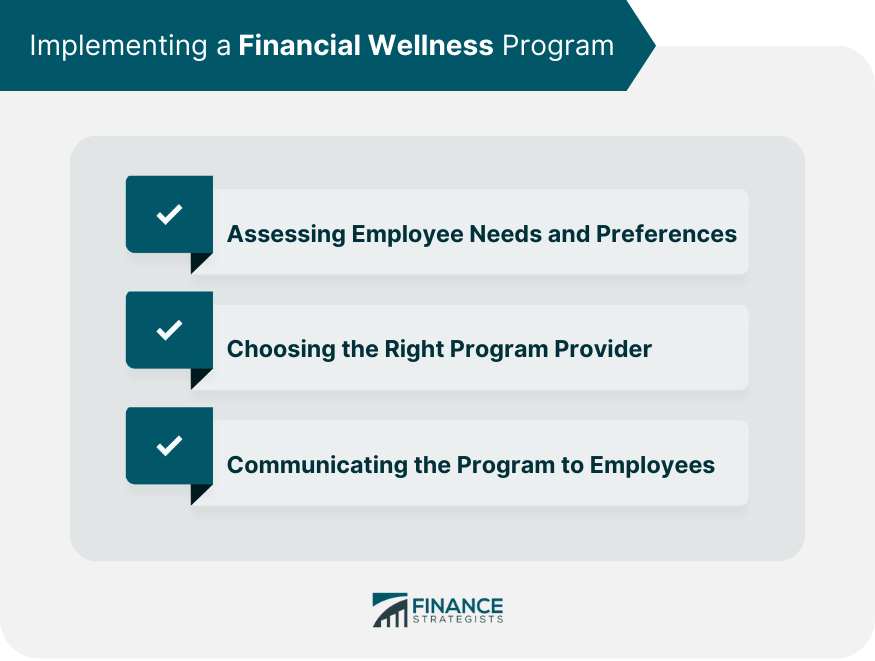Financial wellness refers to an individual's ability to maintain a healthy financial life by effectively managing their income, expenses, savings, and investments. It is crucial for both personal and professional well-being, as it helps individuals make informed financial decisions and reduces stress related to money matters. A financial wellness program is a comprehensive approach designed to educate, support, and empower individuals to achieve and maintain financial health. A financial wellness program provides valuable resources and education, helping individuals understand essential financial concepts, products, and strategies. This increased knowledge enables them to make better financial decisions and achieve their goals. Financial stress can negatively impact an individual's mental and physical health and hinder productivity at work. A financial wellness program can alleviate financial stress by equipping individuals with the tools and knowledge they need to manage their financial situation effectively. By promoting budgeting, saving, investing, and debt management, a financial wellness program helps individuals develop and maintain healthy financial habits, leading to long-term financial stability. Employees who feel supported in their financial well-being are more likely to be satisfied with their jobs and remain loyal to their employers, reducing turnover and recruitment costs. A financial wellness program can help individuals better prepare for retirement by teaching them about savings strategies, investment options, and retirement benefits. A successful financial wellness program includes seminars and workshops covering various topics, such as budgeting, credit management, investing, and retirement planning. Access to online resources, such as articles, videos, and interactive tools, can supplement in-person workshops and provide ongoing education and support. Recommended reading materials can help individuals better understand personal finance concepts and strategies. A financial wellness program should teach various budgeting methods and provide tools like templates and software to help individuals create and maintain a budget. Tracking expenses is essential for effective budgeting. A financial wellness program should offer recommendations for expense-tracking apps or spreadsheets. Encouraging regular financial check-ins and goal-setting can help individuals stay on track with their budgets and financial plans. A financial wellness program should provide guidance on managing and reducing debt, including prioritizing high-interest debts and creating a debt repayment plan. The program should educate individuals about debt consolidation and refinancing options, helping them determine whether these strategies suit their situation. Credit counseling services can offer personalized guidance and support for individuals struggling with debt or seeking to improve their credit. A financial wellness program should emphasize the importance of building an emergency fund and provide guidance on how to achieve this goal. Investing is a critical component of long-term financial stability. A financial wellness program should teach individuals about investment options, risks, and strategies. The program should educate employees about their employer-sponsored retirement plans, including contribution options, matching programs, and investment choices. A financial wellness program should cover the basics of life, health, and disability insurance, helping individuals understand their options and select appropriate coverage. The program should also provide information on property and casualty insurance, such as homeowners, renters, and auto insurance, to help individuals protect their valuable assets. Long-term care planning is an essential aspect of risk management. A financial wellness program should educate individuals about the costs and options associated with long-term care. Understanding Social Security benefits is crucial for retirement planning. A financial wellness program should provide guidance on how to analyze and maximize these benefits. The program should teach various retirement savings strategies, including maximizing employer-sponsored plans, utilizing IRAs, and understanding the impact of taxes on retirement income. Estate planning and wealth transfer are essential components of comprehensive financial wellness. The program should educate individuals about wills, trusts, and other estate planning tools to ensure their wishes are fulfilled, and their assets are protected. Gathering employee input through surveys and focus groups can help organizations determine their employees' financial needs and preferences, ensuring the program is relevant and effective. Understanding the demographics of the workforce can help organizations tailor the program to meet the unique needs of their employees, such as age-specific retirement planning or resources for new parents. Organizations should research various financial wellness program providers to identify the best fit for their needs and budget. The program provider's experience, expertise, and credentials should be considered to ensure the program's quality and effectiveness. When selecting a provider, organizations should weigh the program's costs against its potential benefits, including improved employee productivity, satisfaction, and retention. An effective communication strategy is essential for successfully launching and enrolling a financial wellness program. Employers should promote the program through various channels, such as emails, posters, and meetings. Regular updates and reminders can help keep employees engaged in the program and encourage continued participation. Sharing employee testimonials and success stories can inspire others to take advantage of the financial wellness program and demonstrate its benefits. Tracking employee participation and engagement in the program can help organizations gauge its effectiveness and identify areas for improvement. Monitoring changes in employees' financial stress levels can help organizations evaluate the program's impact on overall well-being and productivity. Assessing employee financial behavior improvements, such as increased savings or reduced debt, can provide insight into the program's long-term effectiveness. Gathering employee feedback and suggestions can help organizations identify areas for improvement and tailor the program to meet their employees' needs better. Organizations should regularly analyze program effectiveness using KPIs and other metrics to ensure the program delivers the desired results. Based on the evaluation results, organizations may need to adjust or expand the program offerings to serve their employees better and achieve their financial wellness goals. A financial wellness program is a comprehensive approach designed to educate, support, and empower individuals to achieve and maintain financial health. By providing valuable resources and education, financial wellness programs can improve financial literacy, reduce financial stress, promote healthier financial habits, enhance retirement planning, and increase employee satisfaction and retention. Key components of a financial wellness program include financial education, budgeting and expense tracking, debt management, savings and investment, insurance and risk management, retirement planning, and estate planning and wealth transfer. To successfully implement a financial wellness program, organizations should assess employee needs and preferences, choose the right program provider, communicate the program to employees, and measure the program's success through key performance indicators (KPIs) and regular program evaluation and improvement. With the right tools and resources, individuals can achieve financial stability and improve their overall well-being.Overview of Financial Wellness Program
Benefits of a Financial Wellness Program
Improved Financial Literacy
Reduced Stress and Increased Productivity
Healthier Financial Habits
Greater Employee Satisfaction and Retention
Enhanced Retirement Planning

Key Components of a Financial Wellness Program
Financial Education
Seminars and Workshops
Online Resources and Tools
Personal Finance Books and Articles
Budgeting and Expense Tracking
Budgeting Tools and Techniques
Expense Tracking Apps and Spreadsheets
Regular Financial Check-ins and Goal-setting
Debt Management
Strategies for Reducing Debt
Debt Consolidation and Refinancing Options
Credit Counseling and Support
Savings and Investment
Emergency Fund Creation
Investment Basics and Strategies
Employer-Sponsored Retirement Plans
Insurance and Risk Management
Life, Health, and Disability Insurance
Property and Casualty Insurance
Long-Term Care Planning
Retirement Planning
Social Security Benefits Analysis
Retirement Savings Strategies
Estate Planning and Wealth Transfer
Implementing a Financial Wellness Program
Assessing Employee Needs and Preferences
Surveys and Focus Groups
Analyzing Employee Demographics
Choosing the Right Program Provider
Researching Available Options
Evaluating Provider Experience and Expertise
Comparing Costs and Benefits
Communicating the Program to Employees
Program Launch and Enrollment
Regular Updates and Reminders
Employee Testimonials and Success Stories

Measuring the Success of a Financial Wellness Program
Key Performance Indicators (KPIs)
Employee Participation and Engagement
Reduction in Financial Stress Levels
Improvement in Financial Behaviors
Regular Program Evaluation and Improvement
Employee Feedback and Suggestions
Analyzing Program Effectiveness
Adjusting and Expanding Program Offerings as Needed
Conclusion
Financial Wellness Program FAQs
A financial wellness program is a comprehensive initiative designed to educate, support, and empower employees to manage their personal finances effectively. It is important because it helps reduce financial stress, fosters healthier financial habits, increases productivity, and enhances employee satisfaction and retention.
A financial wellness program can improve your overall financial health by providing education on personal finance topics, offering tools and resources for budgeting and expense tracking, and promoting healthier financial habits like saving, investing, and managing debt.
The key components of a successful financial wellness program include financial education, budgeting and expense tracking, debt management, savings and investment, insurance and risk management, and retirement planning.
First, to implement a financial wellness program, assess employee needs and preferences through surveys and focus groups. Then, research and choose the right program provider based on experience, expertise, and cost. Finally, communicate the program to employees, promoting enrollment and engagement through regular updates and reminders.
Measure the success of your financial wellness program by tracking key performance indicators (KPIs), such as employee participation, engagement, reduction in financial stress levels, and improvements in financial behaviors. Regularly evaluate the program using employee feedback and analyze its effectiveness, making adjustments and expansions as needed.
True Tamplin is a published author, public speaker, CEO of UpDigital, and founder of Finance Strategists.
True is a Certified Educator in Personal Finance (CEPF®), author of The Handy Financial Ratios Guide, a member of the Society for Advancing Business Editing and Writing, contributes to his financial education site, Finance Strategists, and has spoken to various financial communities such as the CFA Institute, as well as university students like his Alma mater, Biola University, where he received a bachelor of science in business and data analytics.
To learn more about True, visit his personal website or view his author profiles on Amazon, Nasdaq and Forbes.











